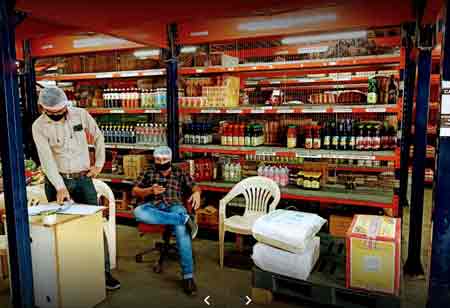Thank you for Subscribing to Food Business Review Weekly Brief
- Home
- Topics
- Alternative Proteins and Plant Based Food
- Beer and Wine
- Canned Beverages
- Coffee And Tea
- Food and Beverage Consulting
- Food and Beverage Financial Service
- Food And Beverages Marketing
- Food Distributors
- Food Ingredients
- Food Sustainability
- Plant Based Food and Beverages
- Seafood Suppliers
- Supplement Manufacturing
- Wine Investment
- News
- Vendor Viewpoint
- CXO Insights
- Conferences
- Newsletter
- CXO Awards
-
Coping with Food Supply Chain Complexities
The global food supply chain faces significant challenges, including food shortages, labor issues, geopolitical events, and shifting consumer demand.

By
Food Business Review | Friday, September 08, 2023
Stay ahead of the industry with exclusive feature stories on the top companies, expert insights and the latest news delivered straight to your inbox. Subscribe today.

The global food supply chain faces numerous challenges that disrupt critical business operations. Food shortages, labor issues, geopolitical events, and shifting consumer demand create complexities that require effective solutions.
The global food supply chain faces significant challenges, including food shortages, labor issues, geopolitical events, and shifting consumer demand. These disruptions can have a detrimental impact on critical business operations. Moreover, with the arrival of the summer season, additional complexities arise for the refrigerated food sector. Despite the ongoing upheavals, solutions are available to mitigate risks and streamline processes. This article delves into the current state of the food supply chain, forecasts future trends, and explores strategies to enhance internal processes for increased speed, agility, and efficiency.
Food shortages have become a reality, exemplified by the current situation where over 20 million tons of grain are trapped in silos near Ukrainian ports. Essential products like olive oil and sunflower seeds are also becoming increasingly challenging to procure. The blockage of critical Ukrainian ports by Russian ships in the Black Sea exacerbates the fragile global supply chains, causing bottlenecks and disruptions. These converging challenges have a cascading effect on businesses worldwide, particularly those operating in the food industry. Faced with scarcity, organizations tend to over-purchase as a short-term strategy to safeguard against potential financial losses. However, this reactive approach exacerbates the issue and can lead to spoilage and wastage. A shift in the "more over less" mentality is necessary to counter this, focusing on finding the appropriate balance.
To achieve balance, relying on simple technologies or numerous Excel documents is insufficient. Instead, intelligent supply chain planning and inventory management solutions offer a comprehensive approach. These solutions leverage vast amounts of data to filter, clean, and process valuable analytics within a company's systems. These technologies can precisely calculate the fine line between overstocking and understocking by analyzing thousands of data points. The result is an exact quantity total that guides informed buying decisions.
By optimizing inventory levels, organizations save significant profit margins and contribute to the greater good. Considering the impact of decisions on environmental, social, and governance (ESG) goals is essential, particularly during critical food shortages. Smart planning and pricing tools provide analytical and formula-based recommendations, reducing the risks associated with seasonal, low-stock, or slow-moving items within congested supply chains. This inventory optimization enables organizations to allocate cash resources more efficiently, potentially addressing other struggling areas of the business, such as strategic hiring strategies.
Consumer demand continually evolves, with factors like inflated prices influencing buying patterns. During the summer months, consumers often prioritize seasonal items like fresh produce, necessitating adjustments to product availability and pricing to counterbalance increased costs. Accurate prediction of consumer demand becomes paramount in maintaining profitability. Retailers have experienced substantial profit losses due to misjudging forward-looking spending trends. As a result, these companies are now planning significant discounts to clear excess inventory, further impacting food, gas, and other prices.
Businesses must equip themselves with tools to accurately forecast future buying patterns to mitigate such risks. This becomes even more critical for food brands due to refrigeration requirements and perishable goods. Understanding which products to purchase and when can prevent significant financial losses resulting from inventory spoilage.
Consumer forecasting and robust supply chain planning solutions empower food distributors to embrace and adapt to change. These systems can identify lower-risk profit opportunities and pricing gaps along the supply chain, enabling continuous improvement in financial results. By running "what-if" scenarios, businesses can proactively respond to dramatic drops in consumer spending. Real-time awareness of disruptions allows for immediate adjustment of inventory levels. With accurate consumer forecasting tools, businesses gain a competitive edge by staying one step ahead.
Businesses can balance overstocking and understocking, optimizing profitability and reducing waste by leveraging intelligent supply chain planning and inventory management tools. Accurate consumer demand forecasting enables businesses to adjust their inventory and pricing strategies, minimizing the impact of market fluctuations. Embracing change and proactively responding to disruptions with agility and efficiency will position food distributors to thrive in the dynamic landscape of the global food supply chain.






